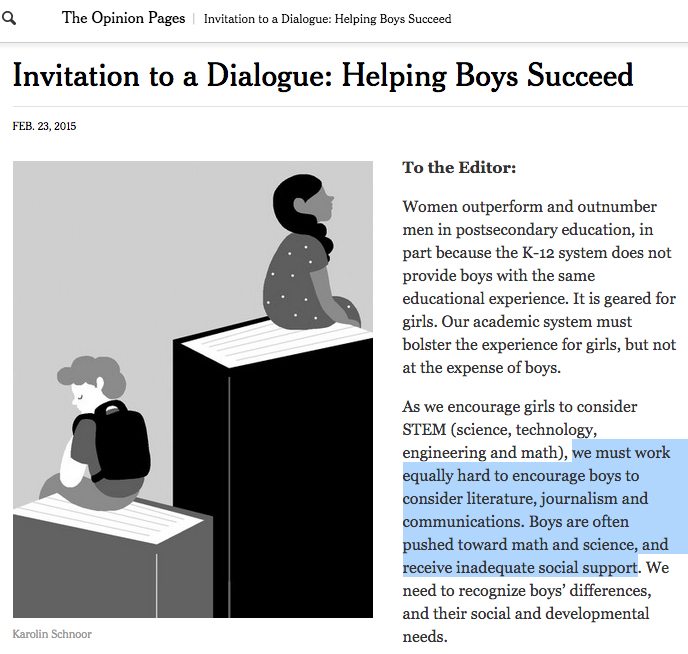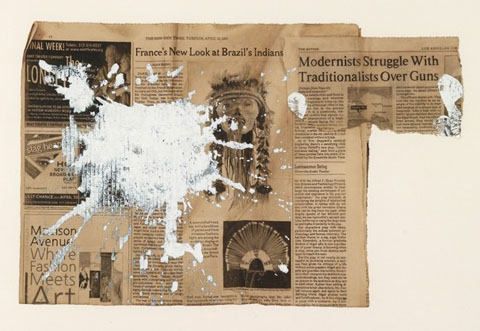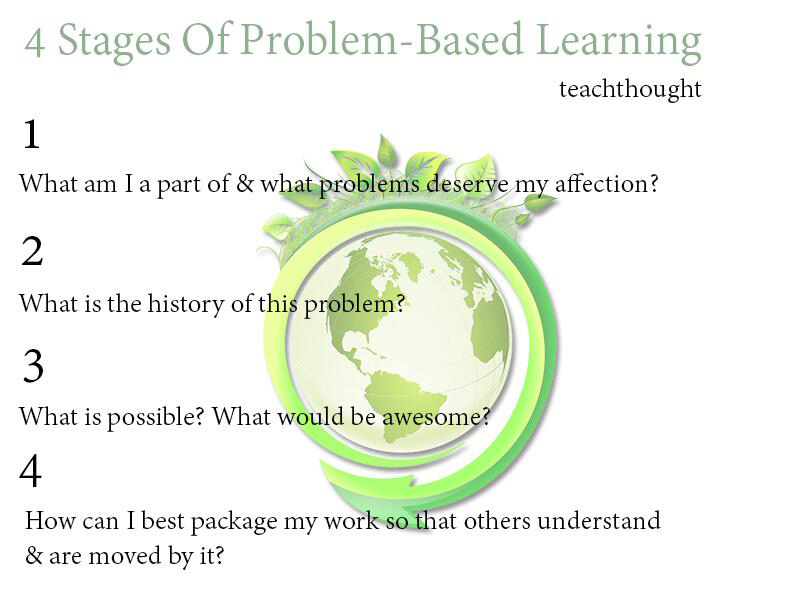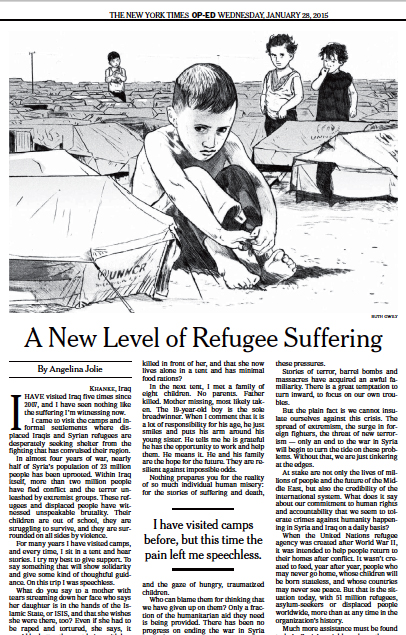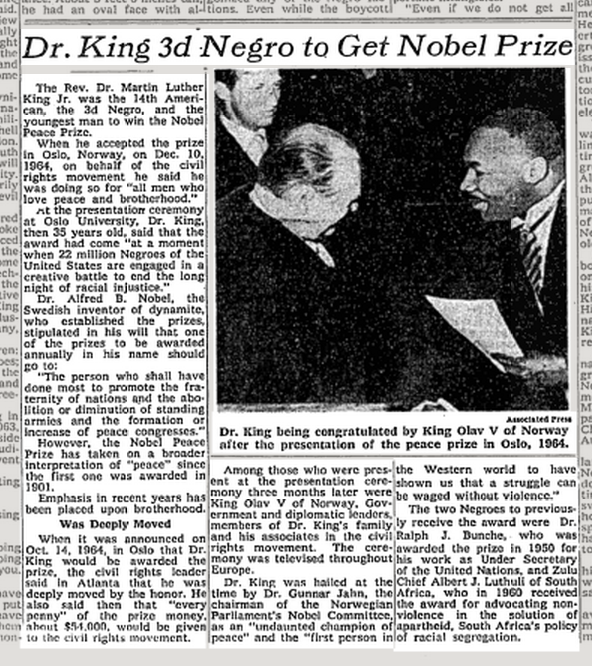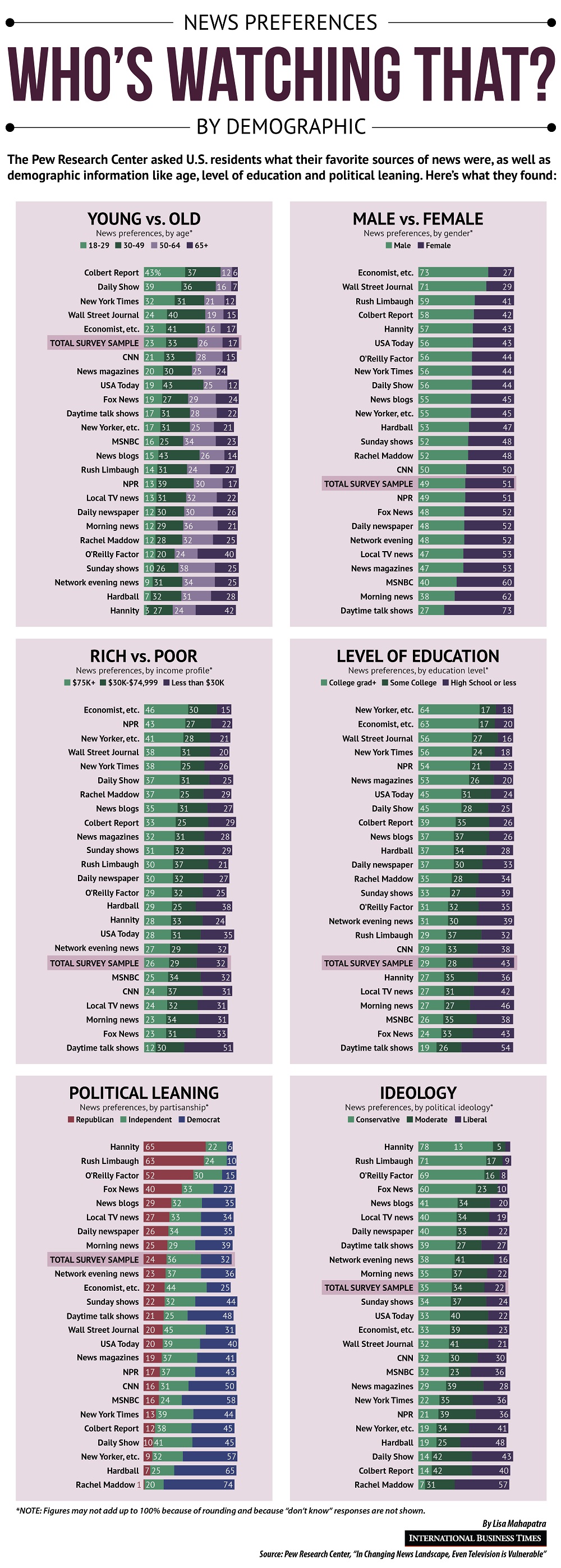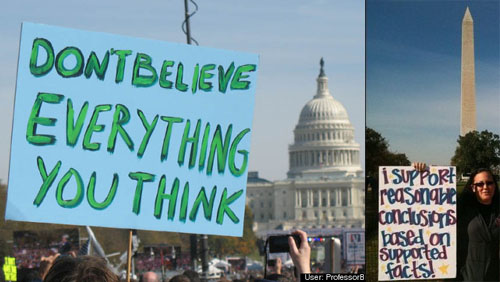Congratulations, Joe (11:20 section):
Joe’s Letter to the Editor
March 22, 2015Concluding Thoughts
“One purpose of a liberal arts education is to make your head a more interesting place to live inside of for the rest of your life.” — Mary Patterson McPherson, President, Bryn Mawr College
“I thought that the future was a place—like Paris or the Arctic Circle. The supposition proved to be mistaken. The future turns out to be something that you make instead of find. It isn’t waiting for your arrival, either with an arrest warrant or a band; it doesn’t care how you come dressed or demand to see a ticket of admission. It’s no further away than the next sentence, the next best guess, the next sketch for the painting of a life’s portrait that may or may not become a masterpiece. The future is an empty canvas or a blank sheet of paper, and if you have the courage of your own thought and your own observation, you can make of it what you will.” — Lewis Lapham
Have patience with everything that remains unsolved in your heart. Try to love the questions themselves, like locked rooms, or books written in a foreign language. Do not now look for the answers. They cannot now be given to you, because you would not be able to live them. And the point is, to live everything. Live the questions now. Perhaps then, someday far in the future, you will gradually, without even noticing it, live your way into the answer. — Rainer Maria Rilke, Letters to a Young Poet.
“It ain’t where ya from, it’s where ya at!” —KRS-ONE, Ruminations
Look how Bruni thinks you should be spending your time
Yik Yak Letters to the Editor
March 14, 2015Captain Kudo’s response
We wrote to USMC Captain Kudo after reading his “How We Learned to Kill,” seeking clarification about his concluding paragraph: 
If this era of war ever ends, and we emerge from the slumber of automated killing to the daylight of moral questioning, we will face a reckoning. If we are honest with ourselves, the answers won’t be simple. I don’t blame Presidents George W. Bush or Barack Obama for these wars. Our elected leaders, after all, are just following orders, no different from the Marine who asks if he can kill a man digging by the side of the road.
We sensed some ambiguity as a class — who was to blame? Officers? Congress? The defense industry? Citizens? Citizens who vote? We didn’t reach consensus in class, and queried Kudo for clarification. From his response:
I was asked a similar question on twitter, my response was: They get their orders from the people. Both presidents were re-elected in the midst of the wars. As JFK wrote in Profiles in Courage: “For in a democracy, every citizen, regardless of his interest in politics, ‘holds office’; everyone of us is in a position of responsibility; and, in the final analysis, the kind of government we get depends upon how we fulfill those responsibilities. We, the people, are the boss, and we will get the kind of political leadership, be it good or bad, that we demand and deserve.”
I would add that the responses I’ve gotten across the board generally reflect the reader’s perspective much more than my own intentions. It is usually that last sentence where such assumptions come to light as people accuse me of failing to take Bush to task or of being an anti-war pacifist. Indeed, that last sentence more than any lays bare the raw political emotions surrounding war and the difficulties that veterans face continuously in trying to tell their stories and simply be heard without judgment. I would encourage your class of young writers to not only keep this in mind but also to bear in mind that even as readers they are not neutral bystanders.
I hope that helps.
Tim
Kudo’s Twitter: https://twitter.com/tkudo
Kudo’s Facebook: https://www.facebook.com/timothy.kudo — he posted a photo of his Op-Ed yesterday.
Chinese Edition: 伊拉克政府军夺回 ISIS 重镇提克里特大部
March 11, 2015Popular Yik Yak App Confers Anonymity and Delivers Abuse
NYT: Popular Yik Yak App Confers Anonymity and Delivers Abuse
… a few hours later, they revised the headline:
Obama in Selma
- NYT: Obama, at Selma Memorial, Says, ‘We Know the March Is Not Yet Over’
- Obama speech on video
- Transcript of Obama’s speech
- John Lewis — one of the protesters 50 years ago who was beaten by police in Selma, and is now a US Congressman — also spoke movingly
- Photo Essay — “Revisiting Selma”
“By college, both sides are to be pitied …”
From Brooks’s “Leaving and Cleaving”:
“For example, to be around college students these days is to observe how many parents have failed to successfully start their child’s transition into adulthood.”
“The mistakes usually begin early in adolescence. The parents don’t create a space where the child can establish independence. They don’t create a context in which the child can be honest about what’s actually happening in his life. The child is forced to deceive in order to both lead a semi-independent life and also maintain parental love.”
“By college, both sides are to be pitied. By hanging on too tight, the parents have created exactly the separation they sought to avoid. The student, meanwhile, does not know if he is worthy of being treated as a dignified adult because his parents haven’t treated him that way. They are heading for a life of miscommunication.“
Karl Ove Knausgaard Travels Through North America
From “My Saga, Part 1: Karl Ove Knausgaard Travels Through North America”
Photographer: Peter van Agtmael
“I was supposed to write about America for an American newspaper, and the last thing I wanted was to seem like an introverted European complaining about how awful everything was here.”
Cole: “A True Picture of Black Skin”
March 3, 2015” … a nation talking to itself.”
March 2, 2015Bullshit
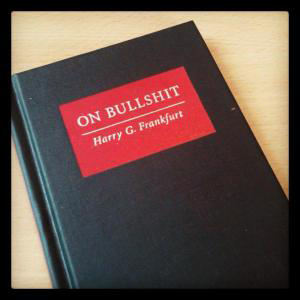 “One of the most salient features of our culture is that there is so much bullshit. Everyone knows this. Each of us contributes his [or her] share. But we tend to take the situation for granted. Most people are rather confident of their ability to recognize bullshit and to avoid being taken in by it. So the phenomenon has not aroused much deliberate concern, or attracted much sustained inquiry.
“One of the most salient features of our culture is that there is so much bullshit. Everyone knows this. Each of us contributes his [or her] share. But we tend to take the situation for granted. Most people are rather confident of their ability to recognize bullshit and to avoid being taken in by it. So the phenomenon has not aroused much deliberate concern, or attracted much sustained inquiry.
In consequence, we have no clear understanding of what bullshit is, why there is so much of it, or what functions it serves.” (p1)
” … she is not concerned with the truth-value of what she says. That is why she cannot be regarded as lying; for she does not presume that she knows the truth, and therefore she cannot be deliberately promulgating a proposition that she presumes to be false: Her statement is grounded neither in a belief that it is true nor, as a lie must be, in a belief that it is not true. It is just this lack of connection to a concern with truth — this indifference to how things really are — that I regard as of the essence of bullshit.” (p10) (more…)
New York Times Remix notes, weeks 8-9
- Evocative objects, meaning, and rhetorical effect: the role of a User’s Guide
- Documenting mediation and choices: human, non-human, environmental
- Statement of Goals & Choices (SoGC); more examples are linked from the Remix assignment
Two paintings from last week (11:20 section)
Édouard Manet’s “Woman Reading.” She seems to be reading a newspaper, which a note in the Impressionism, Fashion, and Modernity exhibit points out, were instrumental in deciding tastes and style in 19th-century Paris. Another note: “But it is not clear that she is reading; she might be using the large pages to screen surreptitious looks coming from her right. In any event, there seems to be a hint of avidity in her expression.”
Room in New York — Edward Hopper
“The White and Gold (No, Blue and Black!) Dress That Melted the Internet”
NYT: “The White and Gold (No, Blue and Black!) Dress That Melted the Internet”
“This definitely felt like a special thing,” said Buzzfeed’s editor in chief, Ben Smith. “It sort of erased the line between web culture and real culture.”
The Internet, and social media in particular, are known for accelerating and accentuating divisions. In a sense, the dress debate was no different. It, too, hinged on a matter of perception. Only in this case, the polarization wasn’t ideological, or political, or racial. It was physical, based on how our brains were processing visual information. And it was harmless.”
Invitation to a Dialogue
Editors’ Note: We invite readers to respond briefly by Thursday for the Sunday Dialogue. We plan to publish responses and a rejoinder in the Sunday Review. Email: letters@nytimes.com
Reflecting on your Op-Eds
“Good writing” is not merely correct, error-free writing; rather, it reflects rigorous reflective and critical thinking.
Process: practicing critical thinking; identifying shared interests & values (Burke) and common ground (stasis)
- Brainstorming & conversation
- Draft
- Feedback & conversation
- Revise (revise = rethink, re-see)
- Maybe revise again
- Edit
- Maybe more revising
- Proofread
Brooks: “I tell college students that by the time they sit down at the keyboard to write their essays, they should be at least 80 percent done. That’s because “writing” is mostly gathering and structuring ideas.”
Lunsford: Good writing makes something happen in the world; good writing is performative.
We also practiced good time management; identifying and using resources; readability and typefaces; and problem solving — what we call self-regulated learning.
Logical fallacy: anecdote
In response to Kristof’s “Straight Talk for White Men.”
Self-regulated learning
At one time or another, we have all observed self-regulated learners. They approach educational tasks with confidence, diligence, and resourcefulness. Perhaps most importantly, self-regulated learners are aware when they know a fact or possess a skill and when they do not. Unlike their passive classmates, self-regulated students proactively seek out information when needed and take the necessary steps to master it. When they encounter obstacles such as poor study conditions, confusing teachers, or abstruse textbooks, they find a way to succeed. Self-regulated learners view acquisition as a systematic and controllable process, and they accept greater responsibility for their achievement outcomes. (Zimmerman, 1990.) The Wikipedia entry on self-regulated learning makes a connection to metacognition.
… and a Depaul Yak puts it more succinctly:

Page A1 photo
February 19, 2015Your Brain Is Primed To Reach False Conclusions
From FiveThirtyEight/Science:
Psychologists have a name for the cognitive bias that makes us prone to assigning a causal relationship to two events simply because they happened one after the other: the “illusion of causality.” A study recently published in the British Journal of Psychology investigates how this illusion influences the way we process new information. Its finding: Causal illusions don’t just cement erroneous ideas in the mind; they can also prevent new information from correcting them.
“… some pretense of communication arises”
Could be helpful in discussions of the rhetoric of social action & discussions of privilege:
“Whenever the need for some pretense of communication arises, those who profit from our oppression call upon us to share our knowledge with them. In other words, it is the responsibility of the oppressed to teach the oppressors their mistakes. I am responsible for educating teachers who dismiss my children’s culture in school. Black and Third World people are expected to educate white people as to our humanity. Women are expected to educate men. Lesbians and gay men are expected to educate the heterosexual world. The oppressors maintain their position and evade responsibility for their own actions. There is a constant drain of energy which might be better used in redefining ourselves and devising realistic scenarios for altering the present and constructing the future.”
— Audre Lorde, “Age, Race, Class, and Sex: Women Redefining Difference”
Aspects of the Culture of Power:
- Issues of power are enacted in classrooms.
- There are codes or rules for participating in power; that is, there is a ‘culture of power.’
- The rules of the culture power are a reflection of the culture of those who have power.
- If you are not already a participant in the culture of power, being told explicitly the rules of that culture makes acquiring power easier.
- Those with power are frequently least aware of–or least willing to acknowledge–its existence. Those with less power are often most aware of its existence.” (24) — Lisa Delpit, Other People’s Children: Cultural Conflict in the Classroom.
Where we are.
February 15, 2015Fashion & Gender
[…] Others, like Ryley Pogensky, a party promoter who was born female and now identifies as “gender queer,” have not.
As he puts it in the catalog: “What is between my legs is not thoroughly who I am. If gender is black and white, I’m gray.”
The idea for the campaign was hatched by Dennis Freedman, who is in charge of Barneys ad campaigns and was formerly the creative director of W magazine, where he oversaw envelope-pushing features that included showing the designer Tom Ford with sex toys and Brad Pitt nearly naked.
In an interview, Mr. Freedman said that the campaign was a chance to create awareness of a community that has in many ways been left behind as gay men and lesbians have moved further and further into the mainstream.
“I was exquisitely aware that in the last decade, the L.G.B. communities have made extraordinary advances, and the transgender community has not shared in that progress,” Mr. Freedman said.
The fashion world has not been terribly quick to embrace transgender people in imagery, although there are exceptions.
Paragraph development and transitions
[P] Point, like a topic sentence
[I] Illustration, which might be data, or a quote, or an example
[E] Explication, which is your commentary or explanation
[P] Every wolf in Yellowstone therefore is more than just a wolf. Imbued with profound symbolic meaning, each wolf embodies the divergent goals of competing social movements involved in the reintroduction debate. Framed by environmentalists and their wise use opponents as another line in the sand in their ongoing battle for the heart and soul of the West, wolf reintroduction is a high-stakes political conflict. [I] Wolf recovery is often portrayed by environmentalists as being symptomatic of a culture in transition–an inevitable change (Askins, 1995). It is an image that plays especially well with the media: “[T]he wolf issue pits the New West against the Old West” (Johnson, 1994, p. 12), a milestone in the “transformation of power” from the Old West (Brandon, 1995, p.8). [E] Wolf restoration clearly represents change, but sound bites that reduce the social struggle over wolves to an “inevitable” transition from the old to the new are inadequate. They do not explain the underlying social issues driving the transformation. They do not capture the essence of social negotiation, the give-and-take of political exchange between social movements struggling to define the western landscape. Nor do they acknowledge that these social issues will remain after the wolf controversy has exited the center stage of public policy discourse.
Wilson, Matthew. “The Wolf in Yellowstone: Science, Symbol, or Politics? Deconstructing the Conflict between Environmentalism and Wise Use.” Society & Natural Resources. 10(1997): 453-468. (more…)
From exploration to 2nd draft to editing
Remember to highlight your selected “best sentence” from your exploratory essay so that we can find it in the second draft of your Op-Ed:
Next up, for revising and editing:
- Stasis
- Logical fallacies — see more in your St. Martin’s Handbook 2.8f: Identifying fallacies; pp. 174-179
- Paragraph development: PIE
- Paragraph transitions
- Titles
Problem-based approaches to advocacy & persuasive writing
February 13, 2015David Carr
Kayla Mueller: NYT & WSJ 2/11/2015
February 11, 2015Key terms for exploration: cosmopolitan, liberal, conservative
The Righteous Mind: Why Good People Are Divided by Politics and Religion, by Jonathan Haidt
From the book description:
As America descends deeper into polarization and paralysis, social psychologist Jonathan Haidt has done the seemingly impossible—challenged conventional thinking about morality, politics, and religion in a way that speaks to everyone on the political spectrum. Drawing on his twenty five years of groundbreaking research on moral psychology, he shows how moral judgments arise not from reason but from gut feelings. He shows why liberals, conservatives, and libertarians have such different intuitions about right and wrong, and he shows why each side is actually right about many of its central concerns.
Is it a “liberal bias,” or is it a “cosmopolitan outlook”?
MK: Well, Jill, leaving you out of it, would you say someone from Mars coming to read The New York Times for a month would recognize any ideological preference?
JA: Well, on the editorial and opinion pages they would.
MK: No, no, on the news pages.
JA: Um, I think that they would recognize a sort of cosmopolitan outlook that reflects that, even as we become international, we’re a New York–based news institution. I can see how the intensity of coverage on certain issues may to some people seem to reflect a liberal point of view. But I actually don’t think it does.
From “A Q&A With Jill Abramson” (part of a series on “The Future of the New York Times”)
-
This chart provides some of the values associated with “conservative” and “liberal” ideologies: I find it helpful always to start with values: what do people value? How did they come to value that?
-
“Cosmopolitanism” in the OED.
-
An excerpt from Moral Politics: How Liberals and Conservatives Think
-
“The question was put to him what country he was from, and he replied, ‘I am a citizen of the world’.” —Diogenes (404-423 BC)
NYT Magazine
February 10, 2015Rhetoric, Identification & Exploration
Something to consider as we think about our Op-Ed essays this week:
Rhetoric & Identification
“A speaker persuades an audience by the use of stylistic identifications; the act of persuasion may be for the purpose of causing the audience to identify itself with the speaker’s interests; and the speaker draws on identification of interests to establish rapport between herself or himself and the audience.” — Kenneth Burke, A Rhetoric of Motives.
Identification, Burke reminds us, occurs when people share some principle in common — that is, when they establish common ground. Persuasion should not begin with absolute confrontation and separation but with the establishment of common ground, from which differences can be worked out. Imagining common ground is the point of our work with stasis and with exigency.
Exploratory Writing
To change yourself (St. Martin’s Handbook: 9a. Arguing for a purpose — page 186)
Sometimes you will find yourself arguing primarily with yourself, and those arguments often take the form of intense meditations on a theme, or even of prayer. In such cases, you may be hoping to transform something in yourself or to reach peace of mind on a troubling subject. [Maybe Jameson is a model of this kind of persuasive writing?]
Leslie Jameson
 Cecily Brown, The Girl Who Had Everything, 1998. Oil on linen, 100 x 110 inches.
Cecily Brown, The Girl Who Had Everything, 1998. Oil on linen, 100 x 110 inches.
If you liked or were moved by Jameson’s “Mark My Words. Maybe.” here is some more:
“Grand Unified Theory of Female Pain”
“Empathy Exams“
Jameson’s home page
Jameson on Twitter
The Problem with Confidence

“In studies, men overestimate their abilities and performance, and women underestimate both. Their performances do not differ in quality.”
David Brooks, “The Problem with Confidence”
Uh oh.
February 8, 2015Kayla Mueller
 “For as long as I live, I will not let this suffering be normal,” she said.
“For as long as I live, I will not let this suffering be normal,” she said.
NYT: ISIS Declares Airstrike Killed a U.S. Hostage
WRD103 memes
February 6, 2015NYT archives on Twitter — highly recommended
38 years ago today in Chicago, an elevated train derailed killing 11 and injuring 183. http://t.co/Aqtd6QA75C pic.twitter.com/XN0GgUDvFF
— NYT Archives (@NYTArchives) February 4, 2015
Search for truth or workforce needs?
9:40 section, it’s interesting & serendipitous that the same day we were talking about the role of truth-seeking behavior in persuasive writing, this appeared in the NYT:
MADISON, Wis. — Gov. Scott Walker abruptly backed off Wednesday from a contentious plan to eliminate the University of Wisconsin System’s public service mission statement known as the “Wisconsin Idea” and replace it with the charge of meeting the state’s workforce needs.
[ … ]
Walker had wanted to insert language in the budget stating the university’s mission was “to meet the state’s workforce needs.” He wanted to remove language saying UW’s mission is to “extend knowledge and its application beyond the boundaries of its campus” and to “serve and stimulate society.” He also wanted to remove the statement “Basic to every purpose of the system is the search for truth.”
NYT: “Walker Backs Off Removing ‘Wisconsin Idea’ From UW Mission”
Here’s the context from class:
Nate Silver presents his BS-meter — modeled on the old terror alert system — to evaluate information sources and “expertise.”  “Probability is the waystone between ignorance and knowledge. Sometimes the pundit who says ‘I don’t know’ is the one you should trust.”
“Probability is the waystone between ignorance and knowledge. Sometimes the pundit who says ‘I don’t know’ is the one you should trust.”
9:40 section
February 4, 2015“How Headlines Change the Way We Think”
From The New Yorker:

Psychologists have long known that first impressions really do matter—what we see, hear, feel, or experience in our first encounter with something colors how we process the rest of it. Articles are no exception. And just as people can manage the impression that they make through their choice of attire, so, too, can the crafting of the headline subtly shift the perception of the text that follows. By drawing attention to certain details or facts, a headline can affect what existing knowledge is activated in your head. By its choice of phrasing, a headline can influence your mindset as you read so that you later recall details that coincide with what you were expecting. For instance, the headline of this article I wrote—”A Gene That Makes You Need Less Sleep?”—is not inaccurate in any way. But it does likely prompt a focus on one specific part of the piece. If I had instead called it “Why We Need Eight Hours of Sleep,” people would remember it differently.
As a result of these shifts in perception, problems arise when a headline is ever so slightly misleading. “Air pollution now leading cause of lung cancer,” ran a headline last year in the U.K. paper Daily Express. The article, however, said no such thing, or, rather, not exactly. Instead, it reported that pollution was a leading “environmental” cause; other causes, like smoking, are still the main culprits. It is easy to understand a decision to run that sort of opening. Caveats don’t fit in single columns, and, once people are intrigued enough to read the story, they’ll get to the nuances just the same. But, as it turns out, reading the piece may not be enough to correct the headline’s misdirection.
Snow Day
February 2, 2015Noticing the words in context
February 1, 2015Rhetorical Analysis Checklist
- The analysis includes a summary of the argument: “claims that … argues that … suggests that … implies that … asserts that …”
- The analysis includes a discussion of how the argument is structured: data, research, narrative, comparison & contrast, a story, etc.
- The analysis includes a discussion of why the argument is made, or even necessary — the exigency — why now? What’s going on in the world that this article is even necessary?
- The analysis includes a discussion of the intended rhetorical effect: to persuade, to cause us to reflect, to change our minds, to be more open-hearted and generous, to take some action, to cause some extended meditation? — what does the writer want us to do?
- The analysis includes a discussion of the audience, the readers, and what rhetorical gestures the writer makes to appeal to that audience — emotions? Logic? Credibility? Tone? What is the writer’s attitude toward readers?
- The tone of your analysis should be explanatory: here’s what this article means, and how it means that.
I also highly recommend reading the Writing Center handout on Rhetorical Analyses and the St. Martin’s Handbook sample Rhetorical Analysis, pp. 181-84.
For week 5: empathy

- Kristof, 1/24/2015: “Where’s the Empathy?”
- Kristof, 1/29/2015: “How Do We Increase Empathy?”
- In response to Kristof, 1/30/2015: four Letters to the Editor
- Leslie Jameson, 4/12/2014: “Mark My Words. Maybe.”
- OED: Empathy
“Evidence They Call Vital: Emoji”
January 29, 2015Comparing the print & digital visual presentations
January 28, 2015Following up on Luhrmann
January 26, 2015All night.
January 25, 2015Planning your essays.
“I tell college students that by the time they sit down at the keyboard to write their essays, they should be at least 80 percent done. That’s because ‘writing’ is mostly gathering and structuring ideas.” David Brooks, December 30, NYT.
Noticing the rhetorically active verbs
January 24, 2015Ayatollah Khamenei Appeals to Western Youth on Islam and Prejudice
NYT: Ayatollah Khamenei Appeals to Western Youth on Islam and Prejudice
TEHRAN — In a rare effort to reach out to the West, Iran’s supreme leader released a letter to youngsters in the United States and Europe imploring them to learn about Islam from original sources and not, as he said in a later posting on Twitter, have it “introduced to you by prejudices.”
[…]
Read the Quran yourself, he advises. “Have you studied the teachings of the Prophet of Islam and his humane, ethical doctrines? Have you ever received the message of Islam from any sources other than the media?”
“Try and find answers yourself,” he writes. “The future of your nations and countries will be in your hands; and also I find that the sense of quest for truth is more vigorous and attentive in your hearts.”
Seven minutes after the speech
January 21, 2015” … when escape from our thoughts is O.K. and when reflection is in order”
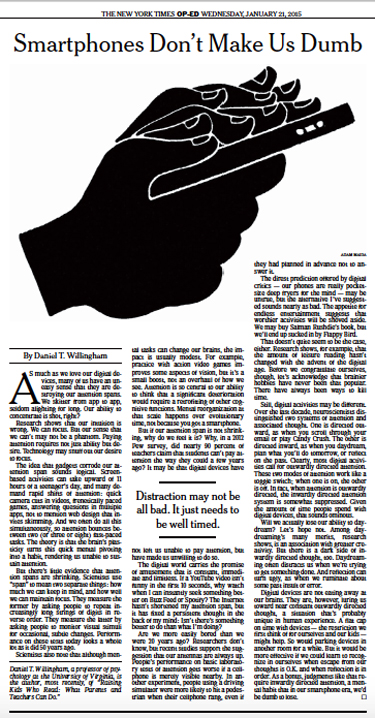
“Digital devices are not eating away at our brains. They are, however, luring us toward near constant outwardly directed thought, a situation that’s probably unique in human experience. A flat cap on time with devices — the restriction we first think of for ourselves and our kids — might help. So would parking devices in another room for a while. But it would be more effective if we could learn to recognize in ourselves when escape from our thoughts is O.K. and when reflection is in order. As a bonus, judgments like that require inwardly directed attention, a mental habit that in our smartphone era, we’d be dumb to lose.”
More than just a day off.
January 20, 2015MLK
January 19, 2015Additional digital tools
For Tumblr readers: https://www.tumblr.com/tagged/nytimes
NYT on Twitter: https://twitter.com/nytimes
NYT on Facebook: https://www.facebook.com/nytimes
Skimmer & Chrome editions
“App” version
Replica edition (full issues via PDF)
NYT: “Why Some Teams Are Smarter Than Others”
Does this kind of research help to explain some of your less-than-stellar group project experiences? Or can you imagine how it might be useful in the future? “Why Some Teams Are Smarter Than Others”
“… teenagers exploring issues of social justice.”
January 14, 2015NYT: “Newspaper in Israel Scrubs Women From a Photo of Paris Unity Rally”
The quote from class: “It’s very, very, very, very, very hard for a nonreligious person to understand the purity of eyes,” Ms. Burshtein said. “By us, men don’t look at women’s photos, period. As long as you don’t know that, then it sounds ridiculous, or changing history or events. But we’re not here to get the events the way they are. We are here to keep the eyes.”
Original photo
Photoshopped; women removed
Remixed; men removed (via Waterford Whisperers)
NYT: “Newspaper in Israel Scrubs Women From a Photo of Paris Unity Rally”
Wilkerson’s “When Will the North Face Its Racism?”
Click image for larger (1200px) version.
Wilkerson’s “When Will the North Face Its Racism?”
Photo: Lily vendors in Chicago, April 1941. Credit Edwin Rosskam/Library of Congres.
This morning at the Ray Meyer gym
January 9, 2015Welcome to WRD 103: Rhetoric & Composition
Great minds discuss ideas.
Average minds discuss events.
Small minds discuss people.
— Eleanor Roosevelt
Life’s prerequisites are courtesy and kindness, the times tables, fractions, percentages, ratios, reading, writing, some history — the rest is gravy, really.
— Nicholson Baker, “Wrong Answer: The Case Against Algebra II”
WRD 103 introduces you to the forms, methods, expectations, and conventions of college-level academic writing. We also explore and discuss how writing and rhetoric create a contingent relationship between writers, readers, and subjects, and how this relationship affects the drafting, revising, and editing of our written — and increasingly digital and multimodal — projects.
In WRD 103, we will:
- Gain experience reading and writing in multiple genres in multiple modes
- Practice writing in different rhetorical circumstances, marshaling sufficient, plausible support for your arguments and advocacy positions
- Practice shaping the language of written and multimodal discourses to your audiences and purposes, fostering clarity and emphasis by providing explicit and appropriate cues to the main purpose of your texts
- Practice reading and evaluating the writing of others in order to identify the rhetorical strategies at work in written and in multimodal texts.
- You’ll be happy to note, I hope, that we build on your previous knowledge and experiences; that is, we don’t assume that you show up here a blank slate. We assume that you have encountered interesting people, have engaging ideas, and have something to say. A good writing course should prepare you to take those productive ideas into other courses and out into the world, where they belong, and where you can defend them and advocate for them.
Finally, it’s no secret around here that students who take early and regular advantage of DePaul’s Center for Writing-based Learning not only do better in their classes, but also benefit from the interactions with the tutors and staff in the Center.
Critical Thinking Contexts for our Class and for College

Unclear writing, now as always, stems from unclear thinking–both of which ultimately have political and economic implications.
A well cultivated critical thinker:
- Raises vital questions and problems, formulating them clearly and precisely;
- Gathers and assesses relevant information, using abstract ideas to interpret it, effectively comes to well-reasoned conclusions and solutions, testing them against relevant criteria and standards;
- Thinks open-mindedly within alternative systems of thought, recognizing and assessing, as need be, their assumptions, ideologies, implications, and practical consequences; and
- Communicates effectively with others in figuring out solutions to complex problems.
Critical thinking is, in short, self-directed, self-disciplined, self-monitored, and self-corrective thinking. It presupposes assent to rigorous standards of excellence and mindful command of their use. It entails effective communication and problem solving abilities and a commitment to overcome our native egocentrism and sociocentrism. – Adapted from Richard Paul and Linda Elder, The Miniature Guide to Critical Thinking Concepts and Tools, 2008.
“A persistent effort to examine any belief or supposed form of knowledge in the light of the evidence that supports it and the further conclusions to which it tends.” Edward M. Glaser. An Experiment in the Development of Critical Thinking. 1941.
Chaffee’s Definition of Critical Thinking
Critical thinkers are people who have developed thoughtful and well-founded beliefs that guide their choices in every area of their lives. In order to develop the strongest and most accurate beliefs possible, you need to become aware of your own biases, explore situations from many different perspectives, and develop sound reasons to support your points of view. These abilities are the tools you need to become more enlightened and reflective “critical thinker” (p. 28).
For Chaffee, critical thinking involves the following:
- Carefully analyzing and evaluating your beliefs in order to develop the most accurate beliefs possible.
- Viewing situations from different perspectives to develop an in-depth understanding.
- Supporting viewpoints with reasons and evidence to arrive at thoughtful, well-substantiate conclusions.
- Thinking critically about our personal “lenses,” which shape and influence the way we perceive the world.
- Synthesizing information into informed conclusions that we are willing to modify based on new insight. (p. 35)
[From The Thinker’s Way by John Chaffee, Boston: Little, Brown, 1998]




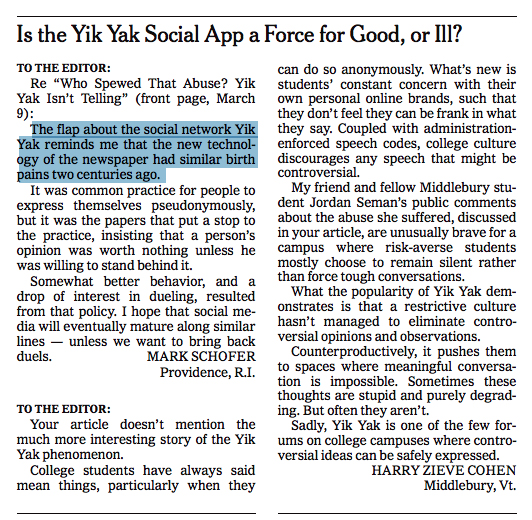

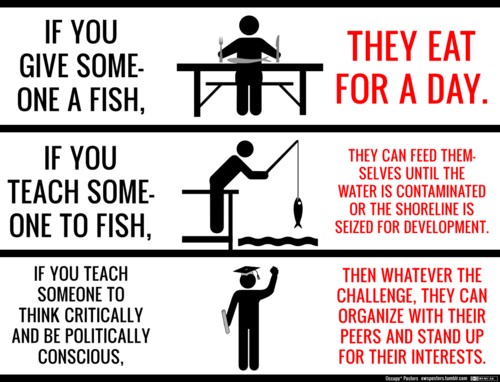






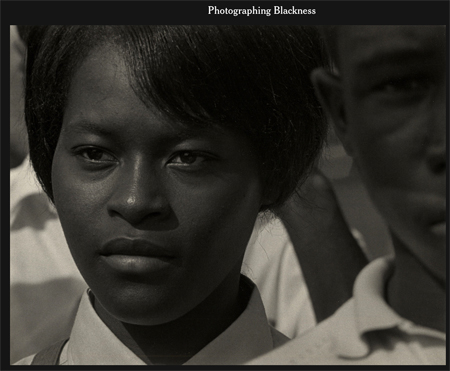



.jpg)

